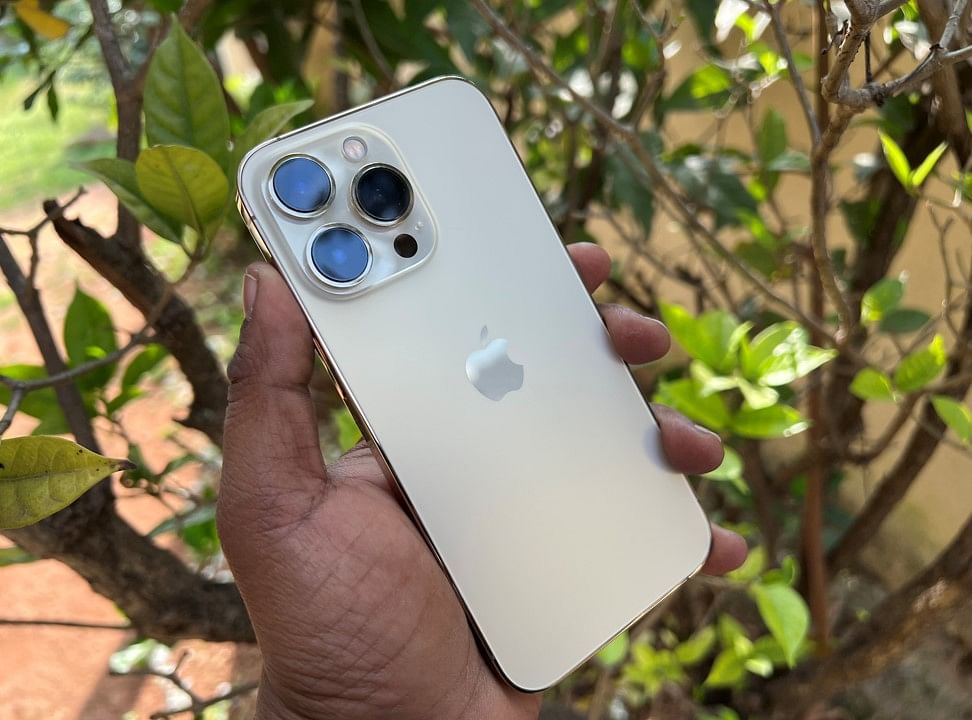

This fall, like the previous years, Apple launched four new handsets-- iPhone 13, 13 mini, 13 Pro and 13 Pro Max.
Depending on the type of model and storage option, the prices range between Rs 69,900 and Rs 1,79,900 in India.
After completing the reviews of three of the four variants, I am here ready with the last and final model of the lot--iPhone 13 Pro.
Design, build quality, and display
The new iPhone retains the flat edge design of the iPhone 12 series (originally of iPhone 4 series) but comes with a bit thicker and heavier body and it does have a good impact on battery performance (later on that).
As you can see from the side-by-side photos of the iPhone 12 Pro and the 13 Pro, there are two noticeable physical changes-- one massive triple camera on the back and the smaller (reduced by 20 percent) front camera notch.
It sports the flushed display and is protected by Ceramic Shield (front and back), which is touted to be the sturdiest protective material used in mobile in the industry. It definitely does a really good job of protecting the screen from scratches.
Also, the device comes with an IP68 rating, meaning it can survive up to 6 meters (19.68 feet) depth underwater for close to 30 minutes.
The rail around the edges is made of surgery-grade stainless steel and it is of premium quality. Our review model is gold and the frame exudes a jewelry-like aura and beautifully blends with the light silver shade of the shell.
Given the high cost of the device, I recommend buyers to get the protective cover to safeguard the iPhone's display from cracking during accidental fall. Apple offers silicone and leather-based shell covers and there is third-party tempered glass for display protection.
Also, it is advisable to buy MagSafe compatible cases and this will save time and trouble to remove the tightly attached cover every time while charging. Unless you prefer to use a wire-based charger.
It should be noted Apple has developed the iPhone 13 series with an environment-friendly process and has used recycled materials for the internal components.
The company says 98 per cent recycled rare earth materials, 99 per cent recycled tungsten used in the taptic engine and on the screen's electrodes, and 100 per cent recycled gold and tin used in the main logic board plate.
Furthermore, six antenna bands around the edges and 10 other components of the device are made of recycled plastic.
Also, Apple has shunned plastic wraps and contents from the device package of all the new iPhone 13 series. By doing this, it has reduced 600 metric tonnes of plastic from entering the environment.
Add to that, the retail box is said to be made of 100 per cent wood fiber developed using recycled material, procured from responsible sources.
Apple iPhone 13 Pro features a 6.1-inch Super Retina XDR OLED (2532x1170p) display with True Tone technology, Wide colour display (P3), Haptic Touch with Pixel density of 460 ppi (pixels per inch), True Tone technology, HDR, and offers a peak brightness of up to 1200 nits. It is one of the best displays I have seen on mobile this year and colors look natural on the screen. Most importantly, readability under direct sunlight is really good and I never faced any pressing issue in terms of viewing content.
Unlike the previous iteration, Apple has ensured both the regular 13 Pro and 13 Pro Max have the same hardware including the camera. The only difference is screen size and battery capacity.
For the first time ever, the iPhone display now supports adaptive ProMotion technology. Depending on the kind of the activities such as web browsing, gaming, watching videos, the device's display panel can intuitively adjust the refresh rate from as low as 10Hz to 120Hz max.
Thanks to this feature, browsing the web and navigating on the phone has definitely improved a lot. However, most of the third-party apps are yet to support ProMotion. Rest assured, it will only get better over time.
Last but not the least, the Face ID and companion sensors, despite being compressed into a smaller module, continue to be the gold standard for facial-based biometric security systems.
Performance
The iPhone 13 Pro houses a 5nm class Apple A15 Bionic chipset with a 64-bit six-core ARMv8 CPU two high-performance cores -- Avalanche and four energy-efficient cores- Blizzard. They come paired with the new 16-core Neural Engine and 5-core GPU.
Also, it houses 15 billion transistors and is capable of performing 15.8 trillion operations per second. It is said to offer 50 percent faster CPU and 30 per cent better graphics processing compared to any of the rival branded phones (with Qualcomm).
As promised, the device is very responsive and quick in terms of launching apps, operating cameras. And, with support for variable display refresh rate up to 120Hz, browsing the internet on the device felt really great. Also, playing Asphalt 9: Legends was an absolutely delightful experience on the iPhone 13 Pro.
As said before, a thicker body has allowed Apple to incorporate bigger capacity cells, and coupled with a power-efficient processor, this has made a remarkable impact on battery life.
Having used the iPhone 12 Pro for more than eight months, I was pretty surprised with the successor's battery performance.
Like for the iPhone 13 (review), I tried my best to drain the battery of the 13 Pro, but failed and could not even bring hit below 20 per cent any day of the review period. Very very impressive.
I'd like to add that the iPhone 13 Pro Max (review) has the longest battery life among the four models and is capable of easily lasting two days under normal usage.
Photography
Besides the battery life, the biggest upgrade we see in the iPhone 13 Pro over the predecessor is the camera hardware.
It boasts an all-new triple 12MP camera system (Telephoto: ƒ/2.8, Wide: ƒ/1.5 and Ultra-Wide: ƒ/1.8 ) and they support Night mode, Deep Fusion, Apple ProRAW, Sensor-shift optical image stabilisation, 3x optical zoom in, 2x optical zoom out; 6x optical zoom range, Digital zoom up to 15x, True Tone flash with Slow Sync, Night mode portraits, Portrait mode with advanced bokeh and Depth Control, Portrait Lighting with six effects Smart HDR 4 for photos and more.
Must read | Apple iPhone 13 mini review
It should be noted that the 12MP Wide camera has a larger sensor with 1.9 µm pixels, and is said to be the largest ever on iPhone to date. It promises to take crisp and detailed photos with less noise and faster shutter speeds.
Well, it does live up to the marketing hype and is undeniable the best camera phone in the industry in 2021.
Be it foggy early morning or baking hot afternoon or pitch darkness of the night, Apple iPhone 13 Pro aces in all possible scenarios. The massive camera sensors' do make a huge impact on the image quality.
I'll start with the Macro mode, a first for an iPhone to date. As you can see in the sample image below, it takes brilliant close-up shots and captures all the details, and comes off sharp and clear.
Also, in other sample photos displayed below, the colours look real. The camera hardware and the advanced ISP (Image Signal Processor) of the Apple A15 Bionic does an excellent job in capturing and reproducing natural colours and minute details of flowers.
I have noticed in some premium phones, struggling to keep the details such as veins of the petals of the flowers in particularly those with red, pink and purple shades.
Here, the iPhone 13 Pro makes no mistakes and dishes out top-notch snaps.
Not just macro photos, Apple iPhone 13 Pro takes superfine ultra-wide shots too.
If you want more vibrant, Apple for the first time has introduced Photography styles right in the native camera app. It offers five options--standard, rich contrast, vibrant, warm and cool.
All effects bring their own charm to the photos and I noted in the iPhone 13 review, I love the rich contrast feature, it makes photos really good and share them on social media platforms.
With these new additions, there is no need to install any third-party camera app to improve the photography experience. Rest assured, Apple iPhone 13 Pro users just have to point and snap to get the best possible photo.
On the front, it houses a feature-rich 12MP (f/2.2) True Depth sensor. It works fine in taking selfies and also the portrait shots-- all six effects: Natural, Studio, Contour, Stage, Stage Mono, High-Key Mono-- come off great.
Like the primary triple camera, the front snapper too is capable of recording ProRes videos for up to 4K at 30 fps and Apple has capped it to 1080p at 30 fps for 128GB capacity model.
It should be noted that the ProRes video takes up huge space. Just one minute of 4K ProRes recording can take up 7GB-8GB of storage, but having said that the quality is really good and stable too.
Another first we see in the iPhone 13 series is the Cinematic mode. It captures This is one of the best camera phone options for video bloggers.
Final thoughts
Compared to the predecessor, Apple iPhone 13 Pro is a moderate upgrade. However, it is a well-defined premium phone, a worthy option for consumers with the iPhone XS series or older models. The familiar flat edge design with a flushed display of the device makes it even more compelling for hardcore Apple fans, as it brings back the nostalgic memories of the iPhone 4 series.
Also, the new iPhone 13 Pro is leagues ahead in terms of photography, processing power, and battery life compared to any of the current crops of premium phones in the market.
In every review of an iPhone, I'd always make a point how it makes so much sense for a phone maker to have full control over hardware and software. It's magical how even with small battery capacity (compared to premium Android phones), the iPhone 13 series models are able to last a whole day even with extreme usage.
Also, the camera of the iPhone 13 Pro is just top class, and the cinematic mode, though a little refinement needed (via software update), makes it stand out among the competition.
Get the latest news on new launches, gadget reviews, apps, cybersecurity, and more on personal technology only on DH Tech.
